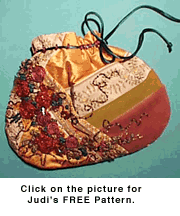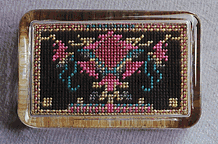By Rita Vainius
 Born
the daughter of two painters and the granddaughter of a tailor, a seamstress
and a blacksmith, Judi got a jump start on the artistic passions and skills
that would come to dominate her life's work. Making things, almost from
"day one", was an integral part of her childhood, surrounded
as she was by the process and fruits of her family's creativity. Not surprisingly,
she learned to sew, embroider, knit and crochet as soon as she could manage
the tools. Her fervent wish, at any holiday that involved gift giving,
was to receive craft and needlework supplies. Even at school, she would
"beg out" of recess on order to decorate the class bulletin boards. Born
the daughter of two painters and the granddaughter of a tailor, a seamstress
and a blacksmith, Judi got a jump start on the artistic passions and skills
that would come to dominate her life's work. Making things, almost from
"day one", was an integral part of her childhood, surrounded
as she was by the process and fruits of her family's creativity. Not surprisingly,
she learned to sew, embroider, knit and crochet as soon as she could manage
the tools. Her fervent wish, at any holiday that involved gift giving,
was to receive craft and needlework supplies. Even at school, she would
"beg out" of recess on order to decorate the class bulletin boards.
Because of her environment, which fostered and encouraged self expression
and creativity, Judi developed an early confidence and the freedom to experiment
with all manner and shape of materials. At Cornell University, she dual-majored
in Printmaking and Government. Acclaimed printmaker, Arnold Singer, was
her favorite professor and remains a friend. Judi has taught art at all
levels from elementary school through college for the last thirty years.
For most of those years she also worked as a (self-taught) graphic designer.
These two pursuits are very portable, making it easy to move when her husband
Frank's journalism career took them to a new city. She received a Master's
Degree in Fibers from Antioch University in the early eighties. For a time
she worked as a weaver, selling her designs at small shops and occasional
craft fairs, but graphic design was much more lucrative and threads, again,
took the back burner.

Her path to
a career in needlework and craft design began by accident. Judi was a regular
customer at a local yarn shop, The Needlework Attic, which Julie Hubbard,
a friend of hers, owned in Bethesda, Md. While in the shop, following her
natural inclination to help a fellow customer choose yarn colors for a
sweater, Julie offered her a job. Judi's reply was: "Minimum wage,
ME? I don't think so...When do I start!". She began by working retail
one day a week and teaching all the shop's needlepoint classes and workshops.
This re-ignited her own passion for needlework, and she began designing
in needlepoint. Before long her work came to the attention of "the
powers that be" and she received magazine assignments. At this stage,
she did not have charting experience, which she taught herself later by
trial and error. To this day she still stitches first and charts from her
finished piece.
Judi's reputation has grown by leaps and bounds in the past eight years.
She currently designs for numerous magazines and manufacturers and has
written three books and produced two videos on stitching techniques and
silk ribbon embroidery.
For the past six years Judi has been working with 300 women in rural
cooperatives in Guatemala converting woven, embroidered and sewn local
crafts into products for the American market. The group, Mayan Hands, produces
clothing, accessories and greeting cards for the Smithsonian Institution
in Washington, DC, as well as retail shops and mail order catalogs.
Judi's design
ideas germinate from a confluence of experience and imagination. The pattern
of a Cathedral floor was used as a background pattern in one design; the
shape of a leaf became the template for the curve of a collar in another.
She uses her other interests: cooking (because it involves mixing ingredients
to produce texture, flavor and color) and quilting (because it makes use
of playful combinations of fabrics and threads, and in the case of crazy
quilt patchwork, all those wonderful embellishment possibilities) as inspiration.
The major key to her prolific creativity, Judi attributes to drawing .
At all times there is a sketch pad at hand in her purse, her car, her bedside
table and next to the easy chair. Not only can she record her impressions
at the moment inspiration dawns, but by doing so, she guarantees the idea
won't elude her memory and vanish into thin air.
Judi's preparations for designing are minimal, starting with a few lines
on canvas, fabric or paper, with her sketch nearby for reference and perhaps
some color notes in marker or pencil. This allows her design to evolve.
The editors Judi works with allow her the liberty of letting her work unfold
in unexpected directions. They might request particular color combinations
or suggest some general guidelines for the pattern desired.
"Heavily
patterned and intricate", is the way Judi describes her personal style.
It is not unusual for her to use forty or more colors in one pattern alone.
Combining techniques such as cross stitch with ribbon embroidery, applique
with crewel work or needlepoint with surface embellishment and beadwork
are just her "cup of tea". She finds her work is becoming more
complex. This is due to her recent philosophical inclination to understand
how the mind works, and the ways internal and external dialogue develop,
are conducted and overlap. She finds the mechanics of how information gets
ingested, processed, and transformed to take shape as speech, gestures
or ideas fascinating. This metaphysical approach is the direct outcome
of a major health crisis endured five years ago, which altered her way
of thinking and seeing the world and life. She became almost blind in one
eye for two months and, as a visual artist, this "shook her to the
roots". Her trend toward intricacy and the appeal of tiny beads, fine
mesh canvas and lush silks was awakened when she realized she might lose
the ability to use them in her work. Another aspect of her introspection
is putting pen to paper and writing short stories, though not for publication.
 Judi has been
using Caron threads since before her professional design career. She discovered
them at The Needlework Attic. She loves Waterlilies, Watercolours and Impressions.
In addition to their exquisite visual appeal, they just feel wonderful,
and this is an integral part of the joy of stitching. Judi is ecstatic
that someone with such a fabulous eye for color and feel for texture as
Lois Caron embodies, has devoted her own career to inventing, developing
and hand-dyeing fibers for devoted and avid needleworkers such as herself.
Her favorite use of the Caron threads is to combine several colors to create
a dappled effect. Judi has been
using Caron threads since before her professional design career. She discovered
them at The Needlework Attic. She loves Waterlilies, Watercolours and Impressions.
In addition to their exquisite visual appeal, they just feel wonderful,
and this is an integral part of the joy of stitching. Judi is ecstatic
that someone with such a fabulous eye for color and feel for texture as
Lois Caron embodies, has devoted her own career to inventing, developing
and hand-dyeing fibers for devoted and avid needleworkers such as herself.
Her favorite use of the Caron threads is to combine several colors to create
a dappled effect.
Judi's intricate,
personal work is sold only by commission but her needlework, stitchery
and craft designs are published by fifteen different magazines and five
manufacturers and are available as kits, project sheets and published charts.
The "Peacock Feather Box" is a chart that Sudberry House makes
available with the box for which it was designed. Judi continues to teach
at trade shows and on request at private shops. Her specialties are needlepoint,
ribbon embroidery and foundation piecing.
Many of Judi's needlework and cross stitch designs are available from
Sudberry House @ (800) 243-2607. Her pre-printed foundation piecing POSSIBILITY
PANELS are available from HTC Handler Textile @ (800) 666-0335 or at your
local quilt, fabric or craft retailer. Be sure to look for her designs
in current and back issues of craft magazines such as "Arts &
Crafts", "Cross Stitcher", Better Homes and Gardens - Special
Interest Publications, Harris Publications, "Crafts Magazine",
"Quick and Easy Crafts", McCall"s Quick Quilts" and
more. For information about her upcoming trade show teaching schedule,
Judi may be contacted via e-mail at judineedle@aol.com .
COPYRIGHT NOTICE: None of these designs can be reproduced or distributed in any form (including
electronic) without the prior written permission of Judi Kauffman.
|

